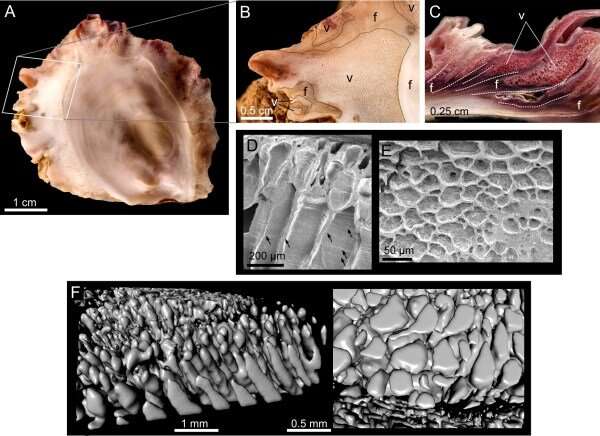Oysters produce 3-D structures organised by physical processes

Scientists from the University of Granada (UGR) have discovered that oysters are capable of producing three-dimensional structures organized by physical (colloidal) processes—the result of which resembles a solid foam—by using a unique technique, similar to that of a 3-D printer. This technique enables them to develop their shell structures sheet-by-sheet, which resolves the problem of limited extrapallial space (the small space that separates the mollusc from its shell). The findings of this study have been published in the prestigious Journal of the Royal Society Interface.
Oysters and, in general, mollusks (as well as other groups of invertebrates) form their shells in an extremely small space (much less than one micron) that sits between the living tissue that secretes the shell (the mantle) and the growth surface of the shell that exists in all mollusks. This is the so-called extrapallial space (pallium meaning mantle). It takes the form of a very thin film and it is filled with a watery liquid called extrapallial fluid. It is therefore quite extraordinary that oysters can produce vesicles (hollow cavities) that measure tens—sometimes hundreds—of microns in diameter through this very small space.
The Gryphaeidae family of oysters was a major group during the Jurassic (between 201 and 145 million years ago), although today there remain very few. Some groups of this family exclusively developed, from around the Cretaceous period, a highly porous material called vesicular.
"This material is made of vesicles filled with a watery liquid, surrounded by calcitic walls. As this is not a very dense material, through the interleaving of vesicular lenses, the oyster develops a shell that is both strong and lightweight. It also means that thick shells can be produced with a considerable saving in construction material, which is metabolically costly," explains Professor Antonio Checa, a researcher at the UGR's Department of Stratigraphy and Palaeontology and the main author of this work.
The study carried out at the UGR focused on how these oysters build their vesicular layers. "Apart from other techniques, we relied on three-dimensional reconstructions and measurements of the vesicular layers of present-day gryphaeid oysters taken with a micro-computed tomography scanner from the UGR's Centre for Scientific Instrumentation (CIC). All the results show that the vesicular material has topological properties and behaviors similar to those of a solid foam," explains Checa.
An emulsion within the extrapallial space
The researchers have concluded that the oyster produces this material by first creating an emulsion within the extrapallial space between the liquid-like precursor of the calcite walls and the extrapallial fluid. Importantly, foams (gas–liquid systems) and emulsions (liquid–liquid systems) are colloidal systems that obey the same laws and behave similarly. When growth occurs, the liquid precursor of the calcite crystallizes, creating 'bubbles', the walls of which solidify. These are then incorporated into the vesicular layer, at the same time as the extrapallial space moves, and, within it, the emulsion continues to evolve.
"For this mechanism to work, each mantle cell must be able to recognize (via contact recognition) the component or components (liquid precursor for calcite or extrapallial fluid) of the emulsion with which it is in contact, and to continue to secrete one or the other, according to this information," says the UGR professor.
While the process of creating foams typically takes place in large spaces, and bubbles are created and disappear all at once, foam oysters have developed their own 'technology' that enables them to develop these sheet-by-sheet, much like a 3-D printer. In this way, they have solved the problem of the space restrictions of the extrapallial space. Therefore, the vesicular material of oysters is under a dual control: physical (self-organization of an emulsion) and biological (sophisticated cellular behavior).
The mineralised materials secreted by organisms, of which there is a wide variety, pose very interesting biophysical problems. They are also of significant interest in the field of material science because they have exceptional biomechanical properties (lightness, strength, and flexibility), beyond those of their individual components (basically calcium carbonate and organic matter). Hence, they provide inspiration for the development of new highly functional synthetic compounds.
More information: Antonio G. Checa et al. Foamy oysters: vesicular microstructure production in the Gryphaeidae via emulsification, Journal of The Royal Society Interface (2020). DOI: 10.1098/rsif.2020.0505
Journal information: Journal of the Royal Society Interface
Provided by University of Granada



















